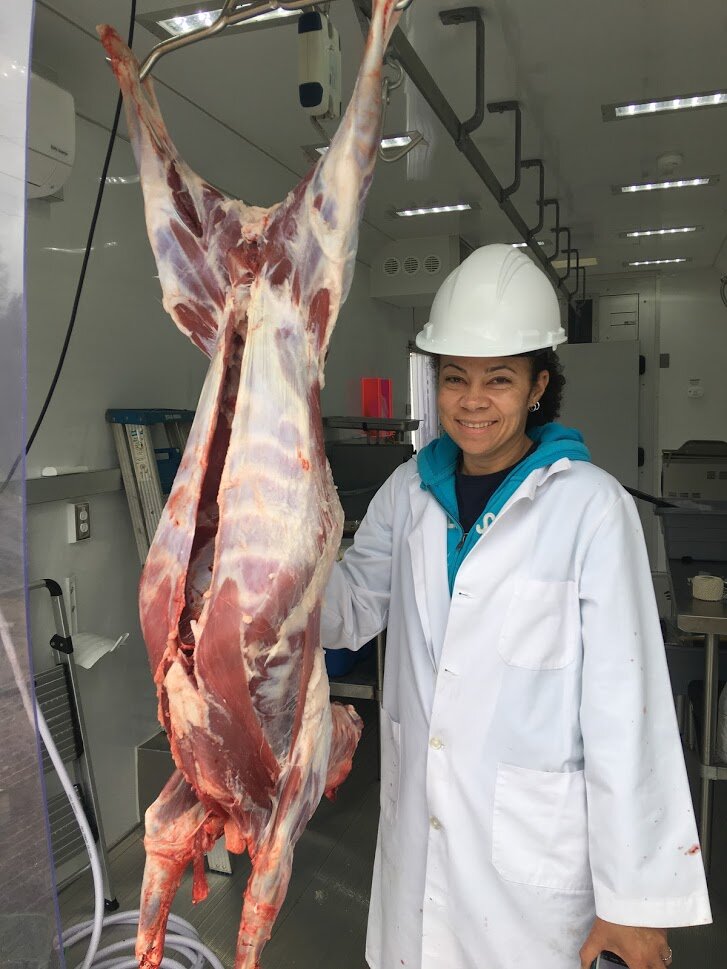VSU’S Mobile Processing Unit On The Move Soon
Dr. O'Brien with lamb carcass
Small Ruminant Producers Have a New Resource for Marketing Their Products
Even before the COVID-19 pandemic impacted meat processing plants around the nation, small ruminant producers in Virginia were struggling to find facilities to process their sheep and goats for market.
Not only are there limited meat processing facilities in Central Virginia, but often these small producers must compete with larger livestock operations just to get on the schedule at a processing plant, resulting in waits as long as 10 months during the pandemic, said Dr. Dahlia O’Brien, Virginia Cooperative Extension (VCE) small ruminant specialist at Virginia State University (VSU).
Often these small producers must travel hours from their farms to get to a processing plant, leave their animals there to be slaughtered and then return for the meat products they hope to market.
Having to wait long periods to get appointments and round-trip travel costs can negatively impact the farmers’ ability to make a profit on their products. Scientists at VSU also need ways to process their small ruminants to further their research. “In talking to producers, agents and researchers, it was evident we are lacking processing facilities in Central Virginia. There’s just not any easily accessible,” O’Brien said.
That’s why a team of Extension specialists and researchers at VSU applied for a grant in 2015 from the U.S. Department of Agriculture’s National Institute of Food and Agriculture (USDA NIFA). O’Brien, who is the principal investigator, was awarded $249,582 to design and build a custom-made mobile unit to give small producers access to much needed processing capabilities and to aid VSU scientists in their research.
VSU’s Small Ruminant Mobile Processing Unit has been in the making for five years, but is scheduled to finally be unveiled and fully operational this spring. It couldn’t come soon enough for O’Brien and many small ruminant producers.
According to data from the USDA’s National Agricultural Statistics Service (NASS), there were 73,000 sheep and 48,000 goats in Virginia in 2019. The number of beginning farmers interested in raising small ruminants, especially hair sheep, is also growing in the state, O’Brien added.
Small Ruminant Mobile Processing Unit
The long-awaited unit faced numerous unforeseen delays in the final design approval, purchasing process, fabrication and test runs. But O’Brien said ensuring that the mobile unit was designed to meet the needs of small producers has remained at the forefront of the project. The unit couldn’t come at a better time, especially in light of the pandemic, which closed some meat processing plants and caused others to work with limited staff after COVID-19 outbreaks around the country.
The unit will be initially housed at VSU’s Randolph Farm, a 416-acre research and education facility. The plan is to have docking sites around the state, O’Brien said. A unit coordinator/butcher will assist with educational programming related to small ruminant processing, operate the unit and work with producers to set up processing.
VSU worked closely with the Virginia Department of Agriculture and Consumer Services to develop the unit and to ensure it meets all state and federal regulations and guidelines. O’Brien, who joined VSU in 2013, was involved in a similar project when she worked at Delaware State University. She collaborated with researchers there and also worked closely with Dr. Stephan Wildeus, small ruminant researcher at the Agricultural Research Station at VSU, to design and beta test the unit.
Pricing guidelines for leasing the trailer will be developed along with future training programs. O’Brien is also working with Dr. Theresa Nartea, VCE marketing & agribusiness Extension specialist at VSU, to work with small ruminant producers and associations to build a collaborative food hub network for marketing their products.
While it has taken time to get to this point, it feels good to know that all the hurdles have been met, and the unit will soon be in use, O’Brien said. “It took a lot of work and dedication over the last five years to make sure this unit was designed to be functional and to make sure it had everything it needed to be fully operational.”


